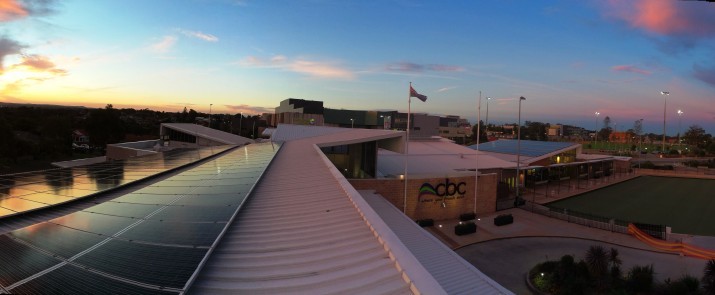Commercial Solar 100kW system on the Charlestown Bowling Club – Media Release featured in the Newcastle Herald
Charlestown Bowling Club’s 100kW Commercial Solar PV system has been featured on the front page of the Business section in Today’s Newcastle Herald. Click here for the online Newcastle Herald article or to view the front page of The Herald’s Business printed section, click here.
This milestone is a boon for the iconic Charlestown Bowling Club and Solar Australia alike, as it signals to Australian businesses and industry stakeholders that commercial solar PV is a viable option to hedge your business against rising energy costs.
See below for the official Media Release:
SOLAR AUSTRALIA AND CHARLESTOWN BOWLING CLUB TURN THE SUN INTO SAVINGS
When Charlestown Bowling Club flicks the switch on its premium new commercial solar panel system this week, it will be well on its way to saving around $30,000 of its annual electricity costs.
Local Newcastle company Solar Australia has installed the 384 panel, net-metered, grid-connected system as part of the first stage in the club’s energy efficiency program, which will be completed shortly with the installation of energy-efficient lighting throughout the club.
Solar Australia’s Todd Watson said switching to commercial solar made perfect sense for Charlestown Bowling Club which has around 8000 members, a diverse range of facilities and hosts many member-based and community activities.
“Not only is the club faced with substantial ongoing electricity costs, it is an organisation that is very community-minded and concerned about its environmental footprint,” Mr Watson said.
“The installation of this 100 kilowatt panel solar system means the club can not only reduce its environmental impact, but also save significantly on electricity costs.”
It is estimated Charlestown Bowling Club is looking at a payback period of around five to six years, with a $30,000 saving – or 20% – per annum on electricity premiums. Mr Watson said it was becoming more common for organisations and corporates to pursue commercial solar as a way of managing energy costs into the future.
“Financially, it makes no sense to be paying ongoing electricity costs – there is no return; whereas the switch to solar means you are investing in an asset you not only own, but that will continue to save you money, with a return on investment of around 20%,” he said.
“Given the uncertainty around energy commodity prices at the moment, solar gives organisations a bit more control over their costs.”
Solar Australia started in Newcastle in 2007 and in that time has completed almost 15,000 solar installations commercially and residentially. It now operates Australia-wide and has a strong vision including energy-efficient lighting and power factor correction.
Mr Watson said the cost of solar installation has come down in the past three years, thanks to the refinement of the manufacturing process, investment into research and development and competition in the manufacturing and distribution markets.
“With a 10-year warranty on installation and a 25-year performance guarantee on the panels, choosing solar energy really is a smart decision for people who are concerned about rising costs and the environment,” he said.
“When we design a solar system there are two parts to it. We look at how an organisation or a household can reduce what it uses in the first place; and then we work out how they can produce as much of what they will use themselves.”
“It has been a fantastic experience working with Charlestown Bowling Club because everyone involved has been on the same page as Solar Australia from the beginning of the project, which had an end-to-end turnaround – from design to commissioning – of less than six months.
“This is a big week for the club, and we are really proud to have worked with them on their journey. We look forward to working with them in the next few months on the switch to energy-efficient lighting.”
Solar Australia’s official media release can be downloaded here.




